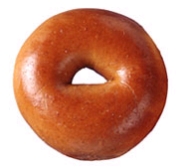
Little more than dough boiled and baked into a circle with a hole in the middle, the humble bagel has become arguably the greatest Jewish contribution to world cuisine.
The perfect bagel should be crusty on the outside and chewy on the inside. To make it, throw a ring of risen dough into boiling water and then bake it. This can be difficult at home as it needs huge water pans and a large oven.
Legend has it that a baker invented the bagel to commemorate the Polish King who saved Vienna from invading Turks in 1683. The shape is variously said to represent the king’s stirrups or the Turkish crescent. Food writer Claudia Roden suggests it was common in south Germany, immigrating firstly to the Polish shtetl (small Jewish village), and then to virtually every major capital in the world.
The name ‘bagel’ may derive from the Middle High German boug (ring) or modern German beugen (to bend). Some spell it as beigel; and in Russia they were called bubliki. The bagel’s first literary appearance was as beuglich in Israel Zangwill’s English classic, Children of the Ghetto, 1892.
Bagel vendors were a familiar fixture of the shtetl and urban ghetto. Often it was a job for orphan children. Licensed adults and illegal freelancers used to sell bagels from large baskets or pushcarts, or off a long pole. In early 20th century New York, a bagel bakers’ union representing 300 bakers ensured that only members’ sons could be inducted into the trade.
One urban legend insists that New York water is essential for a ‘true bagel’ but outsiders dismiss this as Big Apple chauvinism. After 1960 bagel-making machines could shape up to 400 bagels an hour. However, many purists still demand the handcrafted variety.
Some people ascribe spiritual qualities to the bagel. Its shape, a perfect endless circle, is said to affirm wholeness and ward off the evil eye. For this reason the bagel is traditionally served with hard-boiled eggs at Jewish life cycle events, like circumcisions, when a woman is in labour, or at funerals.
Bagels are best eaten fresh off the baker’s tray, as they soon turn hard. Then they can be toasted. The classic filling is smoked salmon (lox) and cream cheese but bagels can be cooked with onions, even fruit or chocolate, and coated with sesame or poppy-seed. Bagels are often eaten as a breakfast meal.
The bagel may not in fact be Jewish in origin. The Uygurs, a Muslim herding tribe from north China, are known to have made foodstuffs almost identical to bagels for more than 1800 years.
A bagel without a hole is sometimes sold as a platzl’ or discarded as an over-swollen winker. Indeed, there is a whole lexicon describing bagels that fall short of perfection. For instance, a ‘bracelet’ has a hole that is too big and a ‘pocket-book’ has an off-centre hole. Devotees of the classic New York classic bagel complain that what pass as ‘bagels’ in Israel are just over-sized pretzels.


